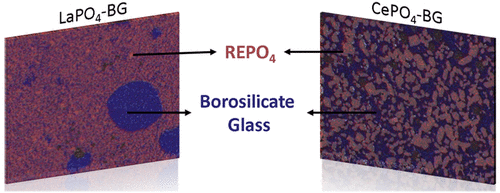当前位置:
X-MOL 学术
›
Cryst. Growth Des.
›
论文详情
Our official English website, www.x-mol.net, welcomes your feedback! (Note: you will need to create a separate account there.)
Crystallization of Rare-Earth Phosphate-Borosilicate Glass Composites Synthesized by a One-Step Coprecipitation Method
Crystal Growth & Design ( IF 3.8 ) Pub Date : 2020-03-10 , DOI: 10.1021/acs.cgd.9b01321 Giovanni Donato 1 , Andrew P. Grosvenor 1
Crystal Growth & Design ( IF 3.8 ) Pub Date : 2020-03-10 , DOI: 10.1021/acs.cgd.9b01321 Giovanni Donato 1 , Andrew P. Grosvenor 1
Affiliation

|
Glass-ceramic composites are heterogeneous materials that have been suggested for use as nuclear waste form materials. A one-step coprecipitation method for synthesizing rare-earth phosphates (REPO4; RE = La or Ce) dispersed in a borosilicate glass (BG) matrix was investigated in this study. The effect of annealing temperature, ceramic loading, and oxidation state of the rare-earth precursor was explored using powder X-ray diffraction, scanning electron microscopy/energy dispersive X-ray spectroscopy, and X-ray absorption near-edge spectroscopy. REPO4 crystallites adopting the monazite structure were observed to form when the annealing temperature was 800–1100 °C in all REPO4–BG composite materials. Lowering the annealing temperature to 700 °C in the LaPO4–BG composite materials caused nm sized LaPO4 crystallites and crystalline SiO2 to form. No changes in the local chemical environment of La or P was observed as a result of the smaller LaPO4 crystallites. CeO2, crystalline SiO2, and Na3Ce(PO4)2 formed in CePO4–BG composite materials in addition to CePO4 when the annealing temperature was below 1100 °C. CePO4 was not observed to form in CePO4–BG composite materials at low ceramic loadings and when annealed at 700 °C. CePO4 was found to be the favored crystal phase over CeO2 and Na3Ce(PO4)2 in the CePO4–BG composite materials when the annealing temperature and ceramic loading was increased. The amount of CePO4 present was also found to be dependent on the oxidation state of the Ce precursor.
中文翻译:

一步共沉淀法合成的稀土磷酸盐-硼硅酸盐玻璃复合材料的结晶
玻璃陶瓷复合材料是异质材料,已被建议用作核废料形式的材料。本研究研究了一种一步沉淀法,用于合成分散在硼硅酸盐玻璃(BG)基质中的稀土磷酸盐(REPO 4 ; RE = La或Ce)。使用粉末X射线衍射,扫描电子显微镜/能量色散X射线光谱和X射线吸收近边缘光谱研究了退火温度,陶瓷负载和稀土前体的氧化态的影响。在所有REPO 4 -BG复合材料中,当退火温度为800-1100°C时,都观察到采用独居石结构的REPO 4晶体形成。在LaPO中将退火温度降低到700°C4 –BG复合材料导致形成纳米级的LaPO 4微晶和结晶SiO 2。由于较小的LaPO 4晶体,未观察到La或P的局部化学环境发生变化。当退火温度低于1100°C时,除了CePO 4之外,在CePO 4 -BG复合材料中还形成了CeO 2,晶体SiO 2和Na 3 Ce(PO 4)2。CEPO 4未观察到形式CEPO 4时在700℃下退火以低负荷陶瓷-BG复合材料和。CePO 4当增加退火温度和陶瓷负载量时,CePO 4 -BG复合材料中的CeO 2和Na 3 Ce(PO 4)2比CeO 2和Na 3 Ce(PO 4)2更有利。还发现存在的CePO 4的量取决于Ce前体的氧化态。
更新日期:2020-04-23
中文翻译:

一步共沉淀法合成的稀土磷酸盐-硼硅酸盐玻璃复合材料的结晶
玻璃陶瓷复合材料是异质材料,已被建议用作核废料形式的材料。本研究研究了一种一步沉淀法,用于合成分散在硼硅酸盐玻璃(BG)基质中的稀土磷酸盐(REPO 4 ; RE = La或Ce)。使用粉末X射线衍射,扫描电子显微镜/能量色散X射线光谱和X射线吸收近边缘光谱研究了退火温度,陶瓷负载和稀土前体的氧化态的影响。在所有REPO 4 -BG复合材料中,当退火温度为800-1100°C时,都观察到采用独居石结构的REPO 4晶体形成。在LaPO中将退火温度降低到700°C4 –BG复合材料导致形成纳米级的LaPO 4微晶和结晶SiO 2。由于较小的LaPO 4晶体,未观察到La或P的局部化学环境发生变化。当退火温度低于1100°C时,除了CePO 4之外,在CePO 4 -BG复合材料中还形成了CeO 2,晶体SiO 2和Na 3 Ce(PO 4)2。CEPO 4未观察到形式CEPO 4时在700℃下退火以低负荷陶瓷-BG复合材料和。CePO 4当增加退火温度和陶瓷负载量时,CePO 4 -BG复合材料中的CeO 2和Na 3 Ce(PO 4)2比CeO 2和Na 3 Ce(PO 4)2更有利。还发现存在的CePO 4的量取决于Ce前体的氧化态。


























 京公网安备 11010802027423号
京公网安备 11010802027423号